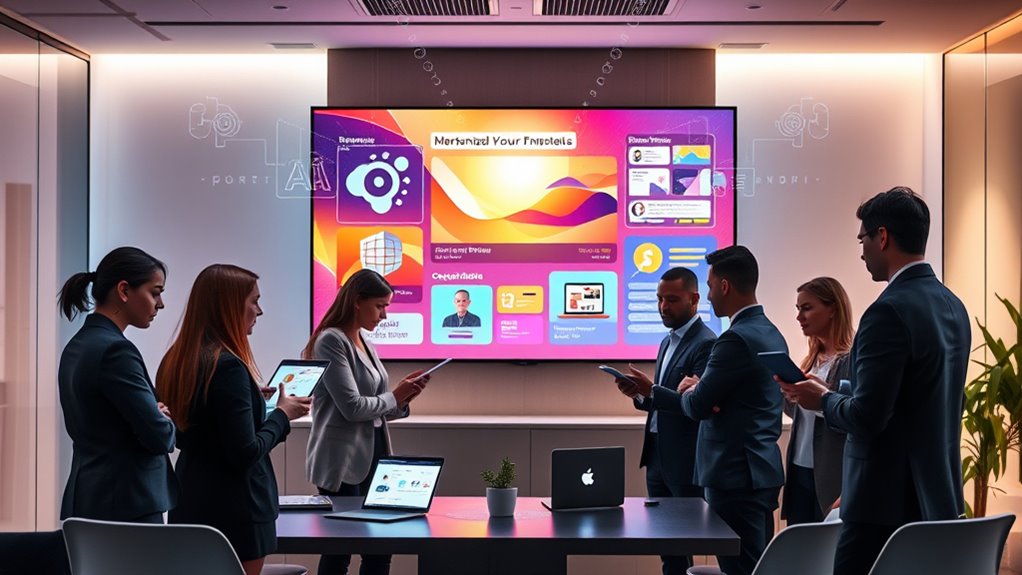Companies use AI to streamline HR by automating candidate screening and managing routine tasks, freeing up time for strategic work. In marketing, AI personalizes customer experiences through targeted content and voice technology, boosting engagement and loyalty. AI also enhances business operations with smarter data analysis and decision-making tools. If you want to discover how these technologies are revolutionizing industries and what’s next, there’s plenty more to explore ahead.
Key Takeaways
- Companies utilize AI in HR to automate recruitment, screening, onboarding, and employee management, improving efficiency and reducing manual tasks.
- AI-driven personalization enhances customer engagement, with targeted content, chatbots, and voice technology increasing satisfaction and loyalty.
- Businesses leverage AI for data analysis, predictive analytics, and automation to streamline operations, reduce cycle times, and boost productivity.
- Voice assistants and chatbots facilitate real-time customer interactions, support voice-based purchases, and meet evolving consumer expectations.
- Ethical AI practices, data privacy, and transparency are prioritized to balance innovation with responsible and sustainable deployment.
Revolutionizing Human Resources With AI

Artificial intelligence is transforming human resources by automating routine tasks and enhancing decision-making. You’ll find AI streamlining recruitment by automatically screening 75% of applicants and generating job descriptions used by 65% of HR professionals. Companies are leveraging AI to filter out unsuitable candidates, saving time and making hiring more efficient. The AI HR market is projected to grow markedly, reaching USD 17.61 billion by 2027, reflecting its increasing adoption. Over 85% of employers report AI improves efficiency, and nearly all Fortune 500 companies use Applicant Tracking Systems (ATS). In employee management, chatbots handle administrative tasks, freeing HR teams for strategic focus. These advancements are revolutionizing HR processes, making them faster, smarter, and more data-driven, ultimately transforming how organizations manage talent. Automation risks 47% of jobs in the US, 35% in the UK and Germany by 2030, highlighting the importance of reskilling and adapting to technological change. Recognizing the importance of spiritual connection in workplace culture, some companies incorporate AI tools that promote team cohesion and employee well-being.
Personalizing Marketing Campaigns Through AI

Have you ever wondered how brands deliver tailored experiences that keep you engaged and coming back? AI-driven personalization makes this possible. About 92% of businesses use it to boost growth, and 80% see increased spending—averaging 38% more—when experiences are personalized. Consumers expect this level of relevance; 71% anticipate personalized interactions, yet 76% get frustrated without them. Incorporating personalization strategies can significantly enhance customer satisfaction and loyalty. Utilizing data-driven insights allows companies to better understand individual preferences and behaviors, leading to more effective targeting. Additionally, advancements in technology integration facilitate more seamless and responsive personalization efforts. Implementing customer data platforms further enables real-time customization and improves overall user experience. The integration of supermarket hours information can help businesses tailor their marketing and operational strategies more effectively, aligning with customer shopping habits. Here’s a quick look at AI personalization trends:
| Adoption | Consumer Expectation | Business Impact |
|---|---|---|
| 92% use AI | 71% expect personalization | 80% see increased spending |
| 69% expand invest | 76% frustrated without it | Fast-growing firms earn 40% more |
| 52% more satisfied | 27% stop shopping without it | Personalization boosts loyalty |
Enhancing Business Operations With AI Agents

As AI agents become increasingly integrated into business operations, companies are harnessing their capabilities to boost efficiency and competitiveness. The AI agent market is projected to grow from $5.29 billion in 2024 to $216.8 billion by 2035, with 85% of enterprises planning adoption by 2025. Major companies, including 79% of Fortune 500 firms, already run active AI projects. These agents streamline workflows, reducing cycle times—biopharma companies, for instance, cut lead generation by 25%—and boosting productivity by up to 35% in research tasks. They automate manual, error-prone processes, enabling faster, more accurate decision-making. Effective data integration and automation help you stay competitive, with AI-led operations expected to resolve most issues autonomously by 2029. Data-driven decision-making is increasingly becoming a core benefit of AI adoption, enabling organizations to adapt swiftly to market changes. Additionally, the ability of AI to handle complex data sets enhances their value in strategic planning and operational efficiency. Incorporating industry-specific knowledge further improves AI performance by tailoring solutions to unique business needs.
Transforming Customer Interactions via Voice Assistants

Voice assistants are changing how you interact with customers by providing personalized and consistent support around the clock. They handle high call volumes quickly, reducing wait times and boosting satisfaction. As more companies adopt these tools, your customer engagement can become more efficient and enjoyable. Additionally, integrating natural materials into your workspace can create a more inviting and productive environment, reflecting a company’s commitment to creativity and sustainability. Advanced AI-driven virtual reality applications are also enhancing training programs, making employee development more engaging and effective. Understanding the divorce process in various states can serve as a useful analogy for organizations navigating complex legal or procedural environments, emphasizing the importance of clear guidelines and compliance. Incorporating specialized skincare solutions, like eye patches, into employee wellness initiatives can further promote health and well-being in the workplace.
Voice-Enabled Engagement Strategies
Transforming customer interactions, voice-enabled engagement strategies leverage the widespread adoption of voice assistants to create more seamless and personalized experiences. With 60% of U.S. consumers using voice assistants, you can expect a major shift in how customers connect with your brand. More than half place their speakers in living rooms, making voice a central touchpoint. Consumers are highly satisfied—93% report positive experiences—and 71% research products via voice before buying. Half of them have completed purchases this way, and 80% who shop via voice are satisfied. As 58% of customers say voice tech has changed their expectations, your business needs to adapt. Voice assistants are transforming retail interactions and will soon replace many in-store visits. Embracing this shift can boost engagement, loyalty, and revenue. The voice industry is valued at $6.4 billion in 2023 and is expected to reach $110 billion within ten years with 32.5% growth, highlighting the rapid expansion and opportunity in voice-enabled strategies. Additionally, integrating organizational strategies can help companies optimize their use of voice technology for better customer engagement. Recognizing the importance of voiceover skills and professional voice talent can also elevate your brand’s voice presence in this evolving landscape. Incorporating textile line innovations into voice applications can further personalize the customer experience and expand your brand’s reach. Understanding market research methods and staying updated on industry trends becomes essential for staying ahead of emerging trends and consumer preferences.
Enhancing Interaction Quality
Enhancing interaction quality is essential for delivering seamless and satisfying customer experiences through voice assistants. It involves measuring key metrics like Customer Satisfaction (CSAT), Net Promoter Score (NPS), and First Call Resolution (FCR) to gauge performance and identify improvement areas. You can boost quality by focusing on:
- Reducing Average Handle Time (AHT) for quicker resolutions
- Maintaining low latency for natural, engaging conversations
- Optimizing AI workflows for faster issue handling
- Collecting real-time feedback for immediate insights
- Continuously analyzing trends to refine voice AI performance
- Leveraging quality assurance tools to track relevance and consistency in responses, ensuring continuous improvement. Regularly reviewing store hours data can help tailor interactions to customer needs more effectively, especially when providing store-specific information.
These strategies help create more personalized, efficient interactions, reducing frustration and increasing user satisfaction. Implementing quality assurance tools like relevance tracking and feedback analysis guarantees your voice assistant consistently improves, elevating overall interaction quality. Call Efficiency Metrics provide concrete data to identify and address areas needing improvement, ensuring your voice assistant performs at its best. Developing a strong understanding of personal development techniques can further enhance your team’s ability to adapt and improve these systems over time.
The Growing Adoption of AI in Business Strategies

Have you noticed how quickly AI is becoming integral to business strategies worldwide? Over the next three years, 92% of executives plan to increase AI spending, with more than half expecting significant investments. Nearly half of technology leaders say AI is fully embedded in their core strategies, reflecting its importance. The number of funded generative AI startups has nearly tripled, showing rapid adoption. While North America remains the leader, Greater China is experiencing notable growth in AI use. Currently, over 35% of companies worldwide incorporate AI into their operations, boosting revenue, efficiency, and market reach. AI’s expanding role is transforming how businesses compete, innovate, and stay ahead in a fast-changing global landscape. AI’s long-term economic impact continues to grow, influencing multiple industries and creating new opportunities for competitive advantage.
The Impact of AI on Workforce Skills and Productivity

As AI transforms the workplace, you’ll notice shifts in the skills valued most by employers, with a growing focus on creativity and human-centric abilities. Productivity can increase considerably if organizations effectively redeploy automation-driven time savings through proper training and reskilling. To stay relevant, you’ll need to continuously adapt your skills and embrace new roles emerging from AI advancements. 83 million jobs may be lost globally, but many new opportunities will also arise in sectors like healthcare, education, and technical fields.
Skill Shift Dynamics
The rapid adoption of AI is transforming workforce skills at an unprecedented pace, forcing employees and organizations to adapt quickly. As AI reshapes job functions, you’ll need to develop skills like complex problem solving, creativity, digital collaboration, adaptability, and ethical judgment. Meanwhile, demand for basic data analysis, routine processing, simple programming, and standardized customer service declines due to automation. Industry-specific shifts include manufacturing moving toward AI-assisted design and human-robot collaboration, while financial roles focus more on algorithm auditing and personalized advising. To stay competitive, you’ll need to:
- Reskill or upskill continually
- Embrace lifelong learning
- Collaborate effectively with AI tools
- Focus on strategic, creative, and ethical tasks
- Adapt swiftly to industry-specific changes
These shifts demand agility and proactive skill development to thrive in an evolving workplace.
Productivity Enhancement Strategies
AI-driven tools are revolutionizing workplace productivity by enabling workers to complete tasks faster and more efficiently. On average, these tools boost productivity by 66% across various job functions. Customer service agents using AI handle 13.8% more inquiries per hour, while business professionals create 59% more documents per hour. Programmers complete 126% more coding projects weekly with AI support. These improvements are statistically significant, confirming real business impact. AI integration is projected to increase overall productivity by 20% by 2035, likely raising GDP growth to around 3% in the 2030s. The benefits are especially strong for less skilled workers, who gain faster transfer of tacit knowledge, boosting their output. Task-specific enhancements include faster report writing, coding, and customer query resolution, accelerating workflows across roles.
Training and Reskilling Needs
Organizations are increasingly supporting employees in developing AI-related skills, recognizing that effective integration of AI into the workplace requires ongoing training. This support helps you stay relevant as AI reshapes job roles and skill demands. Companies are investing in structured programs and resources to facilitate reskilling, making AI education a core part of workforce development. As routine tasks automate, you’ll need to adapt by acquiring skills like complex problem-solving, digital collaboration, and ethical judgment. Employers are also fostering partnerships with educational institutions to align training with industry needs. To thrive, you should focus on continuous learning and upskilling, as more than half of employees globally are expected to require significant reskilling by 2025. Embracing these changes ensures your career remains resilient amid rapid AI-driven transformations.
- Focus on advanced skills like problem-solving and creativity
- Participate in structured AI training programs
- Engage in work-integrated learning and apprenticeships
- Stay updated on evolving job role requirements
- Leverage organizational resources for continuous education
Future Trends: AI as a Core Business Asset

As AI continues to accelerate its integration across industries, it is rapidly becoming a core asset that transforms how businesses operate and compete. You’ll see record-level investment and widespread adoption, especially in asset management, where AI is projected to surpass $21.7 billion by 2034. On-premises solutions dominate financial sectors, offering security and compliance for sensitive data. Companies embed AI into core processes, automating workflows and enabling smarter decision-making, though only 1% are fully mature in deployment. AI also empowers your workforce, automating repetitive tasks and enhancing skills. In marketing, AI drives hyper-personalization and improves customer engagement through chatbots and predictive analytics. Ethical considerations and governance remain critical, balancing innovation with security, transparency, and responsible AI use for sustainable growth.
Frequently Asked Questions
How Do Companies Ensure Ethical AI Use and Data Privacy?
You can guarantee ethical AI use and data privacy by implementing strong governance frameworks, setting clear guidelines, and establishing ethics review boards. Regularly auditing algorithms, managing data with strict privacy policies, and employing techniques like differential privacy help protect sensitive information. Additionally, you should use diverse training data, monitor for bias, and involve humans in decision-making processes to maintain fairness and accountability.
What Skills Do Employees Need to Work Effectively With AI Tools?
Ever wonder what skills help you excel with AI tools? You need basic digital literacy to navigate AI platforms confidently and data analysis skills to interpret insights accurately. Prompt engineering is essential for crafting effective queries, while understanding AI limitations guides responsible use. Strong communication helps you collaborate seamlessly, and critical thinking ensures you evaluate AI outputs properly. Staying adaptable and continuously learning keeps you ahead in leveraging AI effectively for your organization.
How Does AI Adoption Affect Organizational Culture and Change Management?
When you adopt AI, your organizational culture can either thrive or hinder progress. An adaptable, supportive culture boosts AI integration, increases employee engagement, and fosters innovation. It encourages open communication, reduces resistance, and promotes continuous learning. By addressing fears and emphasizing collaboration, you help your team embrace change. Strong leadership and transparency are key, empowering everyone to leverage AI effectively and ensuring smooth, successful transformation across your organization.
What Are the Challenges in Integrating AI Across Different Business Units?
Imagine you’re in a sci-fi movie, trying to connect different AI systems across units. The main challenge is the limited interoperability between these systems, making integration complex and costly. You also face obstacles like misaligned workflows, lack of clear leadership, and resistance from teams. These issues slow down adoption, hinder collaboration, and prevent you from realizing the full potential of AI across your organization.
How Will AI Impact Employment Levels and Job Security Long-Term?
AI will reshape employment levels and job security over the long term by creating new roles and displacing others. You might see some jobs eliminated, especially routine tasks, but overall, there’s a net job gain expected. To stay secure, you’ll need to develop critical skills like creativity, problem-solving, and adaptability. Continuous learning and reskilling are essential, as AI shifts demand toward more advanced, human-centered roles in various industries.
Conclusion
Imagine AI as a mighty lighthouse guiding your business through the fog of competition. By embracing its power, you illuminate your HR, marketing, and operations, steering confidently toward innovation. With AI as your steadfast beacon, you’ll navigate the evolving landscape, boosting skills and productivity along the way. As the horizon of technology expands, harness AI now—your ship’s course to future success depends on it.









